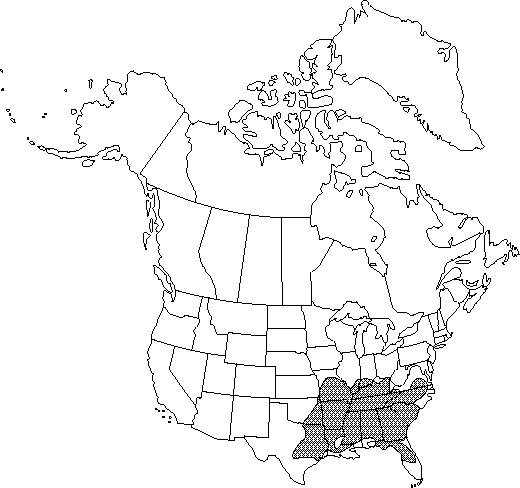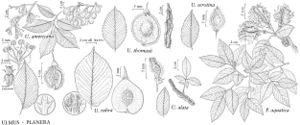Difference between revisions of "Ulmus alata"
Fl. Bor.-Amer. 1: 173. 1803.
FNA>Volume Importer |
imported>Volume Importer |
||
| (7 intermediate revisions by 2 users not shown) | |||
| Line 9: | Line 9: | ||
|common_names=Winged elm;wahoo | |common_names=Winged elm;wahoo | ||
|special_status={{Treatment/ID/Special_status | |special_status={{Treatment/ID/Special_status | ||
| + | |code=W1 | ||
| + | |label= | ||
| + | }}{{Treatment/ID/Special_status | ||
|code=E | |code=E | ||
|label=Endemic | |label=Endemic | ||
}}{{Treatment/ID/Special_status | }}{{Treatment/ID/Special_status | ||
|code=F | |code=F | ||
| − | |label= | + | |label=Illustrated |
| − | |||
| − | |||
| − | |||
}} | }} | ||
|basionyms= | |basionyms= | ||
|synonyms={{Treatment/ID/Synonym | |synonyms={{Treatment/ID/Synonym | ||
| − | |name= | + | |name=Ulmus americana var. alata |
|authority=(Michaux) Spach | |authority=(Michaux) Spach | ||
| + | |rank=variety | ||
}} | }} | ||
|hierarchy=Ulmaceae;Ulmus;Ulmus alata | |hierarchy=Ulmaceae;Ulmus;Ulmus alata | ||
| Line 30: | Line 31: | ||
}}<!-- | }}<!-- | ||
| − | --><span class="statement" id="st- | + | --><span class="statement" id="st-undefined" data-properties=""><b>Trees,</b> 10-18 m; crowns open. <b>Bark</b> light brown to gray with shallow ridges and plates. <b>Wood</b> hard. <b>Branches</b>: young and old-growth branches with opposite, prominent, regular corky wings; twigs reddish brown, pubescent to glabrous. <b>Buds</b>: apex acute; scales brown to rusty, slightly pubescent. <b>Leaves</b>: petiole ca. 2.5 mm, pubescent. <b>Leaf</b> blade lanceolate to oblanceolate, 3-6.9 × 0.6-3.2 cm, base somewhat cordate to oblique, margins doubly serrate, apex acute; surfaces abaxially with trichomes on veins, tufts of pubescence in axils of veins, adaxially glabrous to scabrous. <b>Inflorescences</b> short racemes, not pendulous, less than 2.5 cm; pedicel 2-7 mm, not fully expanded until fruiting stage. <b>Flowers</b>: calyx deeply lobed, symmetric, lobes 5; stamens 5; anthers red. <b>Samaras</b> gray-tan, often reddish tinged, lanceolate to oblong-elliptic, ca. 8 mm, narrowly winged, margins ciliate, cilia white, 1-2 mm. <b>Seeds</b> slightly thickened, not inflated. <b>2n</b> = 28.</span><!-- |
-->{{Treatment/Body | -->{{Treatment/Body | ||
| Line 37: | Line 38: | ||
|elevation=0-600 m | |elevation=0-600 m | ||
|distribution=Ala.;Ark.;Fla.;Ga.;Ill.;Ind.;Kans.;Ky.;La.;Miss.;Mo.;N.C.;Ohio;Okla.;S.C.;Tenn.;Tex.;Va. | |distribution=Ala.;Ark.;Fla.;Ga.;Ill.;Ind.;Kans.;Ky.;La.;Miss.;Mo.;N.C.;Ohio;Okla.;S.C.;Tenn.;Tex.;Va. | ||
| − | |discussion=<p>Often planted as a shade tree in the southern United States, Ulmus alata is also cultivated outside North America.</p><!-- | + | |discussion=<p>Often planted as a shade tree in the southern United States, <i>Ulmus alata</i> is also cultivated outside North America.</p><!-- |
| − | --><p>The name Ulmus pumila was incorrectly applied to this species by Walter in 1788.</p> | + | --><p>The name <i>Ulmus pumila</i> was incorrectly applied to this species by Walter in 1788.</p> |
|tables= | |tables= | ||
|references= | |references= | ||
| Line 47: | Line 48: | ||
-->{{#Taxon: | -->{{#Taxon: | ||
name=Ulmus alata | name=Ulmus alata | ||
| − | |||
|authority=Michaux | |authority=Michaux | ||
|rank=species | |rank=species | ||
|parent rank=genus | |parent rank=genus | ||
| − | |synonyms= | + | |synonyms=Ulmus americana var. alata |
|basionyms= | |basionyms= | ||
|family=Ulmaceae | |family=Ulmaceae | ||
| Line 61: | Line 61: | ||
|publication title=Fl. Bor.-Amer. | |publication title=Fl. Bor.-Amer. | ||
|publication year=1803 | |publication year=1803 | ||
| − | |special status=Endemic; | + | |special status=W1;Endemic;Illustrated |
| − | |source xml=https:// | + | |source xml=https://bitbucket.org/aafc-mbb/fna-data-curation/src/2e0870ddd59836b60bcf96646a41e87ea5a5943a/coarse_grained_fna_xml/V3/V3_1151.xml |
|genus=Ulmus | |genus=Ulmus | ||
|species=Ulmus alata | |species=Ulmus alata | ||
| − | |||
| − | |||
| − | |||
| − | |||
| − | |||
| − | |||
| − | |||
| − | |||
| − | |||
| − | |||
| − | |||
| − | |||
| − | |||
| − | |||
| − | |||
| − | |||
| − | |||
| − | |||
| − | |||
| − | |||
| − | |||
| − | |||
| − | |||
| − | |||
| − | |||
| − | |||
| − | |||
| − | |||
| − | |||
| − | |||
| − | |||
| − | |||
| − | |||
| − | |||
| − | |||
| − | |||
| − | |||
| − | |||
| − | |||
| − | |||
| − | |||
| − | |||
| − | |||
}}<!-- | }}<!-- | ||
-->[[Category:Treatment]][[Category:Ulmus]] | -->[[Category:Treatment]][[Category:Ulmus]] | ||
Latest revision as of 22:46, 5 November 2020
Trees, 10-18 m; crowns open. Bark light brown to gray with shallow ridges and plates. Wood hard. Branches: young and old-growth branches with opposite, prominent, regular corky wings; twigs reddish brown, pubescent to glabrous. Buds: apex acute; scales brown to rusty, slightly pubescent. Leaves: petiole ca. 2.5 mm, pubescent. Leaf blade lanceolate to oblanceolate, 3-6.9 × 0.6-3.2 cm, base somewhat cordate to oblique, margins doubly serrate, apex acute; surfaces abaxially with trichomes on veins, tufts of pubescence in axils of veins, adaxially glabrous to scabrous. Inflorescences short racemes, not pendulous, less than 2.5 cm; pedicel 2-7 mm, not fully expanded until fruiting stage. Flowers: calyx deeply lobed, symmetric, lobes 5; stamens 5; anthers red. Samaras gray-tan, often reddish tinged, lanceolate to oblong-elliptic, ca. 8 mm, narrowly winged, margins ciliate, cilia white, 1-2 mm. Seeds slightly thickened, not inflated. 2n = 28.
Phenology: Flowering late winter–early spring.
Habitat: Alluvial woods and deciduous woodlands, especially dry, acidic woodlands and glades, along fencerows, waste areas, planted as street trees
Elevation: 0-600 m
Distribution

Ala., Ark., Fla., Ga., Ill., Ind., Kans., Ky., La., Miss., Mo., N.C., Ohio, Okla., S.C., Tenn., Tex., Va.
Discussion
Often planted as a shade tree in the southern United States, Ulmus alata is also cultivated outside North America.
The name Ulmus pumila was incorrectly applied to this species by Walter in 1788.
Selected References
None.
